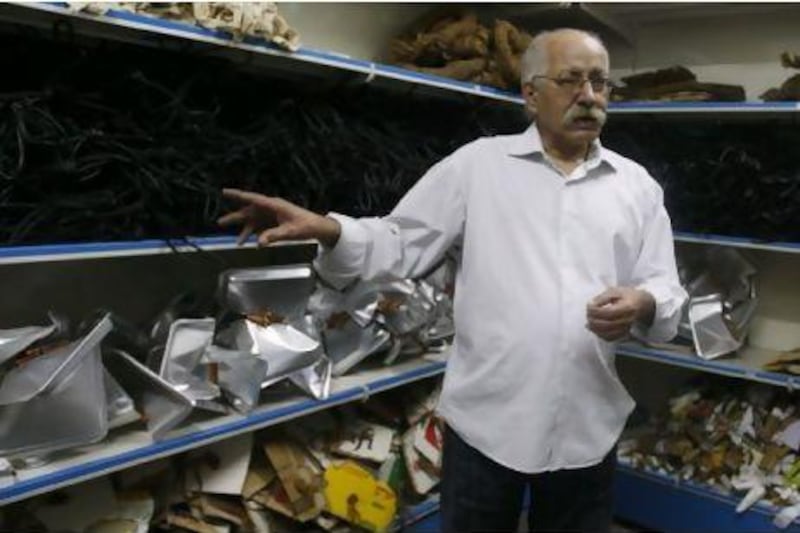DUBAI // Whenever Hassan Sharif sees common objects, say a bundle of cotton, pages of a newspaper or an aluminium tray, he can't help but manipulate them into pieces of art.
But first he has to destroy them.
"I cut, break and tie up the objects, suppressing and removing their functionality," said the 60-year-old artist.
Holding a cotton ball wrapped with metallic wire as an example, he explains: "The innocence of this cotton is pierced and taken away by the reality of this wire."
The cotton balls are just one aspect of Mr Sharif's Experiments and Objects exhibition, which is on at the Qasr al Hosn Cultural Quarter Hall in Abu Dhabi until June 17.
The artist's first solo exhibition has been organised by the Abu Dhabi Authority for Culture and Heritage. The authority plans to launch a book on his works from 1973 to 2011 during the Venice Biennale, which opens to the public tomorrow.
Other pieces of art included newspapers wrapped around wires and cut into smaller pieces, done as Mr Hassan's way of "silencing" the cacophony of the media world.
"It is my way of feeling like I have some control over what is being said and done," he said.
Mr Sharif, from Dubai, is widely acknowledged as one of the first Emiratis to awaken the contemporary art scene in the UAE and is one of the founding fathers of the Emirates Fine Arts Society, which was established in 1980. He has had numerous exhibitions across the UAE as well as abroad.
"I don't like to stick to one way of expression," he said. "Sometimes I paint, sometimes I write and sometimes I simply sit back and contemplate."
Mr Sharif's journey into the art world began in the 1970s with caricatures commenting on everything from social life to the political issues of his home country and the region.
In one of his early caricatures he drew a street with holes in it and a mother searching for her child, who had become lost in one of those holes.
"There was always some sort of construction going and it felt endless and so I poked fun at it and at the same time drew attention to it through my caricatures," he said.
From the plight of the working man, to the ever-elusive dreams of "pan-Arabism", Mr Hassan tackled a variety of themes, some quite controversial, through his caricatures.
"Even erotic themes were allowed," he said. "I could comment on anything."
Watching the changes taking place in the region has inspired Mr Hassan further. He plans to collect hundreds of his caricatures, which were printed in newspapers, with the aim of publishing them in a book by end of the year. He believes the old drawings will stand up, having come during the age of Pan-Arabism as led by Egypt's second president, Gamal Abdel Nasser.
"I am not inspired to draw any new ones, as the ones drawn decades ago still apply today," he said. "The same tyrants are refusing to leave their thrones, and the youth are still dreaming of a nation they can be proud of and have a say in."
One of Mr Sharif's secret places of inspiration is an encyclopaedia, which he browses for ideas and themes. His latest find is the "sand dollar", or sea cookie, related to sea urchins.
"When I am done experimenting with this image, it will have multiple meanings," said Mr Hassan. "To me, it is the act of trying to capture it and manipulate it that I enjoy the most."
The artist never married, admitting he would have made a "bad husband and father".
"I am focused too much on my self and my art," he said. "I can't really give much of myself to anyone else."
Despite his introvert tendencies, he doesn't work far from family, particularly his brother, Hussain Sharif, who is also an artist in the same experimental and contemporary field.
Hussain's trademark is placing faces on the most unlikely of objects, such as rows of tin cans. The brothers' careers are managed by a third brother, Abdul Raheem Sharif.
"I don't help out with the works of Hassan and Hussain because they are my brothers," said Mr Abdul Raheem. "Not at all. It is because I believe in their art as well as the art of many others."
In 2007, Abdul Raheem transformed one of his houses in Dubai into the Flying House gallery, a private non-profit institution set up to promote contemporary Emirati artists.
"This art scene in the UAE has really grown and matured into its own form and identity," said Mr Abdul Raheem.






